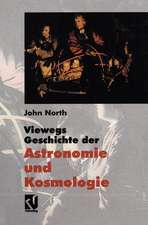God's Clockmaker: Richard of Wallingford and the Invention of Time
Autor John Northen Limba Engleză Hardback – 12 ian 2005
| Toate formatele și edițiile | Preț | Express |
|---|---|---|
| Paperback (1) | 490.42 lei 6-8 săpt. | |
| Bloomsbury Publishing – 14 noi 2006 | 490.42 lei 6-8 săpt. | |
| Hardback (1) | 446.78 lei 6-8 săpt. | |
| Bloomsbury Publishing – 12 ian 2005 | 446.78 lei 6-8 săpt. |
Preț: 446.78 lei
Preț vechi: 692.59 lei
-35% Nou
Puncte Express: 670
Preț estimativ în valută:
85.51€ • 88.13$ • 72.19£
85.51€ • 88.13$ • 72.19£
Carte tipărită la comandă
Livrare economică 03-17 martie
Preluare comenzi: 021 569.72.76
Specificații
ISBN-13: 9781852854515
ISBN-10: 1852854510
Pagini: 462
Dimensiuni: 156 x 234 x 39 mm
Greutate: 0.86 kg
Ediția:New.
Editura: Bloomsbury Publishing
Colecția Hambledon Continuum
Locul publicării:London, United Kingdom
ISBN-10: 1852854510
Pagini: 462
Dimensiuni: 156 x 234 x 39 mm
Greutate: 0.86 kg
Ediția:New.
Editura: Bloomsbury Publishing
Colecția Hambledon Continuum
Locul publicării:London, United Kingdom
Recenzii
"If this book can work a comparable magic on others, inspiring more of us to take up investigation of the same historiographical path, our understanding of the Middle Ages, modernity, and the history of science will be the better for it." Steven P Marrone, Speculuma Journal of Medieval Studies 1 September 2009
'John North...is determined to put Richard on the historical map - and what a map it is. Its sweep and fine-grained detail make his account a veritable tour de force of erudition.' 17/11/2006
'John North...is determined to put Richard on the historical map - and what a map it is. Its sweep and fine-grained detail make his account a veritable tour de force of erudition.' 17/11/2006
Notă biografică
Caracteristici
A superb account of medieval thought and its inheritances from the ancient and Islamic worlds. John North restores Richard of Wallingham and his creation to the prominence they deserve. The book is nothing short of gripping in its technological and philosophical reach. God's Clockmaker was highly popular on its initial publication and is certain to achieve even stronger sales in paperback.
Cuprins
Illustrations
PART ONE: Foundations
1 Eclipse
2 The Black Monks
The Order
Federation
The Monastery
3 Wallingford
The Borough
Son of the Smithy
The Priory
4 Oxford
The Beginnings of the University
Grosseteste: The Forming of the University
Theology and the Sciences
Gloucester College
Rival Institutions
Nine Long Years and More
5 An Astronomer Among Theologians
Cause for Regret
Oxford Theologians Abroad
'Mathematical Pursuits'
Astrology and the Calendar
New Instruments: Rectangulus and Albion
The Astrolabe
6 The State of the Kingdom
The Fall of Edward II
Edward III and the Downfall of Isabella
PART TWO: An Abbot's Rule
7 A New Abbot
Goliath
Avignon
Why Avignon?
Pope John XXII (1316-34)
The Road
The Throne of Costly Grace
Fortune's Wheel
8 Reprove, Persuade, Rebuke
Discordant Notes
A Visitation
The Abbot's Dues
The Leper
A Good Shepherd?
Rights
9 The Visitor Visited
An Abbot in Parliament
Balancing the Books
Enemies and Friends in Adversity
10 The Litigious Abbot
Justice Within Whose Law?
The Mills of St Albans
Hand-Mills and Liberties
Morality and Bloodshed
Trials by Jury
The Men of Redbourn
Isabella's Mill
Mills, Malt and Mas
Windmills
Unflagging Aspirations
PART THREE: Time and the Man
11 Builders and Clockmakers
The Builder
Roger and Laurence of Stoke
12 Horologe and History
Time and the Hour
Water Clocks
The First Cluster of Records
Perpetual Motion
Mechanisms and Motives
Astronomical Motives
Astronomical Motives Questioned
The Mechanical Escapement's First Application?
13 The St Albans Clock
The Treatise
The Manuscripts
The Escapement
The Order of Invention
The St Albans Striking Mechanism
Developments in Italy
Richard of Wallingford ad Engineer
The Building of the Clock
14 Machina Mundi
The Clock as Instrument
Tides and Fortune
On Reading an Astrolabe Dial
The Sun's Variable Motion
The Moon and Dragon
15 Legacy
Time the Controller
Time's Fell Hand
The Man
Dissolution and Survival
PART FOUR: The Springs of Western Science
16 The Migration of Ideas
The Latin Tradition
From Cordoba to Western Monasteries
Al-Khwarizimi in England
The High Tide of Translation
Approaches to the Greek Aristotle
Jewish Contributions
Parallel Worlds: Theology as Censor
Provence and Profatius
17 A Primer in Aristotelian Natural Philosophy
18 Natural Philosophy in Oxford
A Metaphysics of Light
Grosseteste and Thirteenth-Century Optics
Aristotle and Geometry
Aristotle and Scientific System
Rationalists, Empiricists, and God
A New Dynamics
A New Kinematics: The Mertonians
The Rise and Fall of Aristotelian Science
19 The Astronomers
Early Western Astronomy
The Renaissance of the Greek Tradition
Ptolemy's Almagest
A Painful Climb: Student Texts
Ptolemaic Planetary Theory
Astronomical Tables and Techniques
Natural Philosophy and the Astronomers
Heaven and the Heavens
20 The Astrologers
Early History
Oxford Astrology
Exafrenon
21 Instruments of Thought
Mathematics as Instrument
Material Instruments
The Rectangulus
22 Albion
Early Equatoria
Tacit Geometry
New Ways with Old Theory
Sun, Moon and Eclipse
Curves for Functional Relationships
The Fortunes of Albion
23 Epilogue
Notes
Bibliography
Index
PART ONE: Foundations
1 Eclipse
2 The Black Monks
The Order
Federation
The Monastery
3 Wallingford
The Borough
Son of the Smithy
The Priory
4 Oxford
The Beginnings of the University
Grosseteste: The Forming of the University
Theology and the Sciences
Gloucester College
Rival Institutions
Nine Long Years and More
5 An Astronomer Among Theologians
Cause for Regret
Oxford Theologians Abroad
'Mathematical Pursuits'
Astrology and the Calendar
New Instruments: Rectangulus and Albion
The Astrolabe
6 The State of the Kingdom
The Fall of Edward II
Edward III and the Downfall of Isabella
PART TWO: An Abbot's Rule
7 A New Abbot
Goliath
Avignon
Why Avignon?
Pope John XXII (1316-34)
The Road
The Throne of Costly Grace
Fortune's Wheel
8 Reprove, Persuade, Rebuke
Discordant Notes
A Visitation
The Abbot's Dues
The Leper
A Good Shepherd?
Rights
9 The Visitor Visited
An Abbot in Parliament
Balancing the Books
Enemies and Friends in Adversity
10 The Litigious Abbot
Justice Within Whose Law?
The Mills of St Albans
Hand-Mills and Liberties
Morality and Bloodshed
Trials by Jury
The Men of Redbourn
Isabella's Mill
Mills, Malt and Mas
Windmills
Unflagging Aspirations
PART THREE: Time and the Man
11 Builders and Clockmakers
The Builder
Roger and Laurence of Stoke
12 Horologe and History
Time and the Hour
Water Clocks
The First Cluster of Records
Perpetual Motion
Mechanisms and Motives
Astronomical Motives
Astronomical Motives Questioned
The Mechanical Escapement's First Application?
13 The St Albans Clock
The Treatise
The Manuscripts
The Escapement
The Order of Invention
The St Albans Striking Mechanism
Developments in Italy
Richard of Wallingford ad Engineer
The Building of the Clock
14 Machina Mundi
The Clock as Instrument
Tides and Fortune
On Reading an Astrolabe Dial
The Sun's Variable Motion
The Moon and Dragon
15 Legacy
Time the Controller
Time's Fell Hand
The Man
Dissolution and Survival
PART FOUR: The Springs of Western Science
16 The Migration of Ideas
The Latin Tradition
From Cordoba to Western Monasteries
Al-Khwarizimi in England
The High Tide of Translation
Approaches to the Greek Aristotle
Jewish Contributions
Parallel Worlds: Theology as Censor
Provence and Profatius
17 A Primer in Aristotelian Natural Philosophy
18 Natural Philosophy in Oxford
A Metaphysics of Light
Grosseteste and Thirteenth-Century Optics
Aristotle and Geometry
Aristotle and Scientific System
Rationalists, Empiricists, and God
A New Dynamics
A New Kinematics: The Mertonians
The Rise and Fall of Aristotelian Science
19 The Astronomers
Early Western Astronomy
The Renaissance of the Greek Tradition
Ptolemy's Almagest
A Painful Climb: Student Texts
Ptolemaic Planetary Theory
Astronomical Tables and Techniques
Natural Philosophy and the Astronomers
Heaven and the Heavens
20 The Astrologers
Early History
Oxford Astrology
Exafrenon
21 Instruments of Thought
Mathematics as Instrument
Material Instruments
The Rectangulus
22 Albion
Early Equatoria
Tacit Geometry
New Ways with Old Theory
Sun, Moon and Eclipse
Curves for Functional Relationships
The Fortunes of Albion
23 Epilogue
Notes
Bibliography
Index
















